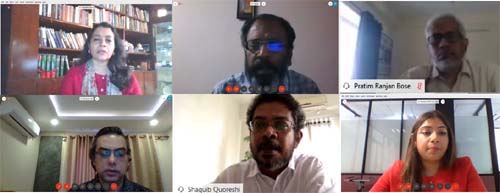On 24 July 2020, the Vivekananda International Foundation (VIF) hosted an online discussion on “Possibility of Developing Regional Value Chain in South Asia”. The panel included, Dr Sreeradha Datta, Mr Bipul Chatterjee, Mr Pratim Bose, Mr Analraj Bhattarai, Mr Shaquib Quoreshi, and Dr Nuwanthi Senaratne. From the VIF, Dr Arvind Gupta, Amb Ranjit Rae, Lt Gen Ravi Sawhney, Mr Aayush Mohanty, and Ms Cchavi Vasisht also participated in the event. The core question raised was whether South Asia is at a cusp, where we can examine the issues regarding the possibility of developing Regional Value Chains (RVCs) in South Asia?
The developments of a multi-modal transportation system have enabled a degree of transformation in the region. A sub-region is becoming connected through cross border transport systems and the possibilities of developing small cohesive sub-regional groupings that would be beneficial for the growth of each of these clusters within the region is becoming a reality. The focus on the political issues often de-rails the economic agendas, and the region fails to harness the greater dividends that lie in economic cooperation among nations. Is it possible to develop enabling conditions that lead to integrated trade linkages and allow market dynamics to play a larger role that could provide an anchor and stability that the region needs?
The outbreak of COVID-19 has adversely affected the global supply chains on which all the countries in the region heavily depended. Could these disruptions provide an opportunity to develop regional production centres of goods & services in the region? The experts recognised that South Asian region has developed connectivity and has the potential to increase value chains. At present, South Asia has value chains for a few sectors, such as food processing, textiles, and jute. However, concerns were raised about the robustness of these value chains and the factors that are holding back these value chains were highlighted during the discussion.
The primary factor that is missing in building robust value chains is the “understanding” among the stakeholders. Often it is debated that the intra-regional trade is low. However, it must be recognised that there are market size discrepancies. There is a need to change the mindset towards it. It was suggested that we should focus on the South Asia Subregional Economic Cooperation (SASEC) grouping to bring brings together Bangladesh, Bhutan, India, Maldives, Myanmar, Nepal, and Sri Lanka in a project-based partnership that aims to promote regional prosperity, improve economic opportunities, and build a better quality of life for the people of the subregion. There is a need for goods and services to reach the market and that is possible with the improved transport connectivity.

The trade profile of the region remains weak. For instance, in the case where India sends ten containers to Bangladesh, only one comes back with goods. The discussion stated the ‘Factors that Affected Trade’ (FAT) under three major themes: trade infrastructure & facilitation, market and regulatory dimensions. Creating an enabling environment is another critical challenge. The bilateral issues and the state level challenges are difficult to address, such as Meghalaya’s coal is transported to Bangladesh via Assam and Tripura due to restrictions imposed; the trading opportunities for sugar and oil are restricted in Bangladesh. Therefore, the policymakers from the region need to collaborate and engage in discussions to eliminate restrictions and enhance RVCs.
Fortunately, South Asia has several alternative means to trade, such as the waterways, railways and the like. More initiatives could be undertaken; for instance, the railways near the Petrapole (the Indian side of Petrapole-Benapole checkpoint between India and Bangladesh) - the old express could be revived. The waterways in Nepal could be used – Gandak and Kosi rivers. India has reached its capacity with Bhutan and Nepal. Trade with Afghanistan is mostly air-based and thus restricted. Therefore, the future growth prospects need to be explored with Bangladesh and Sri Lanka. Given the geographical proximities and existence of informal trade, question was raised, whether the formalisation of the informal trade help in enhancing the RVCs. It was recommended that since the number of products traded informally is less and concentrated in a few sectors, the region could opt for slow transformation of Border Haats (open-air business venues) into Border Economic Zones.
Dr Arvind Gupta delivered the concluding remarks reiterating the need to enhance trade and connectivity – both physical and regulatory connectivity. The idea of developing a single regional window for value chains is one of the options that the countries could adopt to enhance trade facilitation. The goods and services need to move freely. The incremental positive changes taking place in the last few years must continue, and the countries must change their mind-set to help cooperate and collaborate in the RVCs. Especially in the Post-COVID 19 world, the setting up of RVCs would help in integrating trade in the region. The governments in the region would need to initiate domestic policies reform and reduce the regulations to ensure trade in goods and services grow and flourish in the days to come.

 copy.jpg)



Post new comment